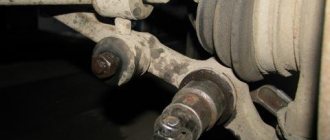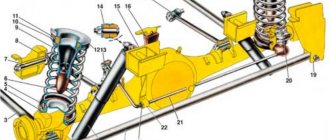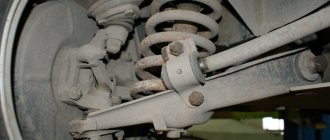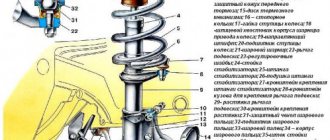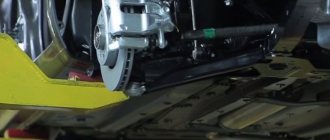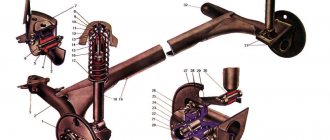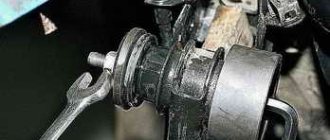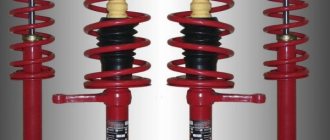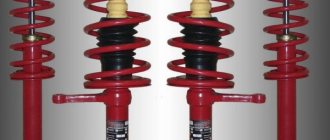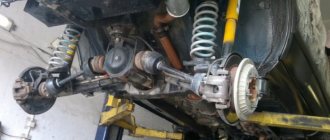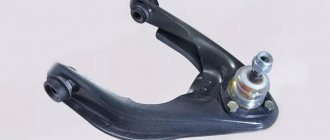I was looking for the cause of the squeaking when turning, and discovered that the transverse link bracket was half torn off and was shaking.
I wonder what will happen if it falls off while driving? Is it possible to get to the landfill without this bracket? Is it possible to scrap it by arriving and leaving with the same car? Nobody needs four in St. Petersburg?
I traveled without it, then welded it for 1000 rubles in the village. The welder was too lazy to install a new one and strengthen it with pads. He promised that he would last 2 months.
The driving experience is wonderful: the car sways, wiggles, and even changes its trajectory at high speed. Now even something is missing - it’s a bit harsh.
Every year he came off for me on the pre. car. I'm talking about the left, not the right, "house".
> I wonder what will happen if it falls off while driving? ====The body will move left and right relative to the rear axle, hitting the flanges of the rear fenders against the rubber of the wheels, which can lead to their cutting.
> Is it possible to get to the landfill without this bracket? ====I drove tens of kilometers without it.
> Is it possible to scrap it by arriving and leaving with the same car? ====Why?! It is simply welded.
Since you are reading this article, it means that you have finally decided to strengthen the body on your VAZ 2101. It doesn’t matter what prompted you to undertake this responsible and time-consuming process: deformation from an impact, car tuning, or just your hands itching, one thing is for sure - the price of repairs will pleasantly surprise you if you do all the repairs yourself.
PURPOSE OF SUSPENSION VAZ 2107
The suspension of the VAZ Seven, like any other car, is necessary for safe and comfortable movement. Its design may seem complicated at first glance, but in reality it is not. The front and rear suspensions are a set of elements whose purpose is to provide an elastic connection between the wheels and the chassis of the car. The main function of the suspension is to reduce shock, vibration and jolts that occur when driving over uneven surfaces, which is inherent in roads with poor quality surfaces. It is worth looking at faults, repairs and modernization of the rear suspension in more detail.1
FRONT SUSPENSION
The VAZ 2107 has a double-wishbone independent suspension with an upper and lower wishbone at the front. The first of them is fixed through the mudguard strut, the second - to the front beam connected to the power elements of the body. The upper and lower arms are secured to each other by means of a steering knuckle and ball joints. To rotate the levers, the suspension design includes silent blocks made of rubber and a metal bushing. The softness and smoothness of the suspension is determined by elements such as springs and shock absorbers, and the stability of the car on the road is determined by the anti-roll bar.
The front suspension of the VAZ 2107 bears greater loads than the rear, so its design is made independent
REAR SUSPENSION
The rear of the car takes up less load than the front, so the suspension has a simpler design - dependent. The wheels of the rear axle of the “seven” have a rigid connection with each other. Such a system today, although outdated, still has positive aspects - high reliability and ease of maintenance.
Node maintenance
During the operation of classic Zhiguli models, several malfunctions associated with stabilizing traction occur:
- wear of stabilizer bushings on VAZ 2107;
- breakage of the upper or lower pin on which the ends of the rod are screwed to the lever;
- separation of the U-shaped fastening strip welded to the lever at the factory.
Broken studs are quite rare and are the result of metal fatigue. The malfunction is characterized by sharp rolls when turning, accompanied by loud metallic knocks. This unpleasant sound is produced by the released end of the rod clinging to the side of the lower arm. It’s quite easy to fix the damage, even while on the road in the middle of a field: a regular bolt and nut are put in place of the torn stud.
The fastening U-shaped strip of thick metal comes off very rarely. Which entails a labor-intensive process of replacing the lower arm, since welding it to the old one is useless, the part will very quickly break again. If any of these two troubles occur, it is possible to drive a car, but only very slowly, especially on turns.
The VAZ “classic” stabilizer bushings are replaced when they wear out approximately once every 20 thousand km. mileage Wear is clearly visible visually; you just have to look under the front of the car and make sure that the rubber bands are cracked and do not cover the traction properly. In advanced cases, bad bushings make themselves felt while driving, when the car sways and tilts dangerously.
To install new bushings, you will have to completely remove the VAZ stabilizer. It is most convenient to carry out work from the inspection hole, although if necessary, you can do without it. To disassemble and replace, you will need a pry bar, 2 13 mm wrenches and a powerful screwdriver. Replacement is carried out as follows:
- It is easiest to remove the rod when the springs are completely unloaded. Therefore, it is recommended to hang both front wheels of the car.
- Using a 13 mm wrench or socket, unscrew the nuts on all brackets.
- Using a pry bar, remove the brackets from the studs one by one.
- Remove the rod and use a sharp tool to mark the position of the old bushings, as well as the right and left sides.
- Old rubber bands can be cut off with a knife.
When finished, the rod must be thoroughly soaped (do not lubricate it with oil!) and new bushings must be tightened, and then the assembly must be assembled. When assembling, it is undesirable to confuse the right and left ends of the stabilizer, which is why marks were placed on them. In the end, you need to check the car while driving and go to a car service center to correct the wheel alignment of the front wheels.
REAR SUSPENSION - DESCRIPTION
The rear suspension of the VAZ 2107 is practically no different from the mechanism of other classic Zhiguli cars. The dependent design is simple, but has some features. Its main structural elements are:
- springs;
- telescopic shock absorbers;
- rods;
- beam.
Design of the rear suspension of the VAZ 2107: 1. Lower longitudinal rod; 2. Lower insulating gasket of the suspension spring; 3. Lower support cup of the suspension spring; 4. Compression stroke buffer; 5. Bolt for fastening the upper longitudinal rod; 6. Bracket for fastening the upper longitudinal rod; 7. Suspension spring; 8. Compression stroke buffer support; 9. Upper spring gasket ring; 10. Upper spring insulating gasket; 11. Upper support cup of the suspension spring; 12. Pressure regulator drive lever support; 13. Rubber bushing for the pressure regulator drive lever; 14. Shock absorber mounting stud washer; 15. Rubber bushings for shock absorber eye; 16. Rear shock absorber mounting bracket; 17. Additional compression progress buffer; 18. Spacer washer; 19. Spacer sleeve of the lower longitudinal rod; 20. Rubber bushing of the lower longitudinal rod; 21. Bracket for fastening the lower longitudinal rod; 22. Bracket for fastening the upper longitudinal rod to the bridge beam; 23. Spacer sleeve for transverse and longitudinal rods; 24. Rubber bushing for the upper longitudinal and transverse rods; 25. Rear shock absorber; 26. Bracket for attaching the transverse rod to the body; 27. Brake pressure regulator; 28. Protective cover for pressure regulator; 29. Pressure regulator drive lever axis; 30. Pressure regulator mounting bolts; 31. Pressure regulator drive lever; 32. Clip of the lever support sleeve; 33. Support sleeve; 34. Cross rod; 35. Cross bar mounting bracket support plate
REAR BEAM
The main structural element of the rear suspension is a beam (stocking) or rear axle, through which the rear wheels are connected to each other. With the help of this unit, not only the suspension elements are fixed, but also the rear axle structure - the gearbox and axle shafts - is assembled together.
The main element of the rear suspension is the stocking
SHOCK ABSORBERS
The main function performed by suspension shock absorbers is vibration damping, i.e., preventing the car from rocking when driving over uneven surfaces. The presence of such an element and its proper operation directly affects the predictability of the car’s behavior, as well as the comfort of movement and extending the service life of other suspension elements. The upper part of the shock absorber is attached to the power element of the body, and the lower part is attached to the rear axle beam through a bracket and rubber bushings.
Shock absorbers act as elements that dampen vibrations
SPRINGS
Another integral element of both rear and front suspension is the spring. In addition to shock absorbers, it also provides a comfortable ride. In addition, the element prevents the vehicle from tipping over when making sharp turns. By design, the spring is made of a steel rod twisted into a spiral. From below, the part is installed in a special bowl of the rear beam through a rubber gasket that prevents squeaks. The spring element on top also rests against the bowl on the body through the gasket.
The spring, in addition to shock absorbers, is responsible for comfortable movement in the car.
JET ROD
The rear axle stocking is fixed to the body of the “seven” using reaction rods. The latter are present in the amount of five pieces - four longitudinal and one transverse (Panhard rod). Longitudinal rods prevent and prevent the bridge from moving back and forth, and transverse rods prevent movement when lateral loads appear. The rods are connected to the rear axle beam through rubber bushings.
Reaction rods of the rear axle keep it from longitudinal and lateral displacements
HIPS
The rear suspension compression buffers are made of rubber, are inserted into the body holes provided for them and are located inside the springs. An additional bumper is installed above the rear beam and secured to the bottom of the car. The purpose of the buffers is to prevent hard impacts when driving on bad roads when the suspension is fully compressed.
Rear suspension bumpers prevent breakdown during heavy sagging
FakeHeader
Comments 16
Guys, tell me, I put nivo springs on the front, cut off 1 turn, the car seemed to become stiffer, but the front began to sway a lot, as if the shock absorbers weren’t working! Before this, there were stock springs of -1.5 turns and everything was fine, they worked with a bang. (Kayaba gas shock absorbers)
The main thing is that such collective farming does not have a fatal outcome.
are you talking about flipping?
I installed them for myself) in the blog photo there is how to trim them) I saw an option where they just turn them over and that’s it. that is, the right one is placed on the left side and there is no need to trim
I'm going too
I have these, you cut them with a grinder and put them down - it really makes the car softer and more collected
Do you mean trim? Can you explain. I’m just thinking about getting these for myself too.
there you need to cut out a little bit and that’s it)
Did it get better with them?
I just bought it today, I will install it in the near future)
Did it get better with them?
I wrote above what’s the use, plus the springs don’t fall out when hanging (Phobos minus 40), they are generally designed for lifting (elevating) the car so that the shock absorber is in the operating range, and since the longitudinal link mounting bolt is offset relative to the shock absorber mounting bolt, then if We stupidly turn this house down - it stupidly won’t fit there, so we cut out a piece with a grinder, adjust it in place, and put it in place. As for the fatal outcome, nothing terrible can happen there in principle, the shock absorber is not a guiding element of the suspension like a bar, so even if it falls off (and this is, in principle, unrealistic in this case if the owner of the car looks after the condition of the car), nothing will happen happens - the car stupidly stops reacting adequately to irregularities and you will immediately feel it, so everything is humming.
MALFUNCTIONS OF THE REAR SUSPENSION OF VAZ 2107
Rear suspension elements do not fail as often as the front ones, but sometimes they also have to be replaced, since even the most reliable parts wear out over time. The breakdown or damage of a particular product is indicated by characteristic signs that allow you to correctly identify the problem and quickly repair the suspension.
KNOCKING
Knocks in the rear suspension can be of different types and the reasons for their occurrence are also different:
- knocking sound when starting. The malfunction occurs when one of the rear axle reaction rods or the brackets that hold them break. To solve the problem, it is necessary to inspect the suspension, identify the damaged rod and replace it;
- knocking noises while driving. Broken silent blocks of jet rods can knock. Over time, the metal bushing simply begins to dangle in the rubber, and the bridge “walks,” which leads to the appearance of extraneous sounds. The malfunction is treated by replacing the rubber bushings of the rear axle rods;
- knocking noise when the suspension is compressed too hard. This happens when the bump stop is damaged, causing the suspension to “break through.” Therefore, it is necessary to inspect the buffer elements and replace the failed ones.
VIDEO: KNOCKING ON ZHIGULI VEHICLES WHEN DRIVING AWAY
SUSPENSION BREAKOUTS
Such a concept as “breakdown” occurs when the suspension does not cope with its function. There may be several reasons for this:
- rear axle overload. The suspension can often “punch” due to an overloaded rear axle, for example, if the car is heavily loaded. In this case, you need to unload the rear axle;
- breakage or settling of the spring. Despite the fact that the springs are made of durable steel, they still sag over time, especially with frequent transportation of goods. The way out of the situation is to install new or stiffer springs;
- failure of shock absorbers. If the shock absorbers are unable to dampen vibrations, then full operation of the suspension is impossible. The shock-absorbing elements will need to be replaced.
THE CAR IS PULLING TO THE SIDEWAY
Sometimes with the suspension of the VAZ “Seven” there are such nuances when the car pulls to the side. Let's list the reasons why this can happen:
- spring breakage or settling. Due to a damaged spring, the car will stand unevenly on the road, which may cause it to move to one side. The spring will need to be replaced;
Damage to the spring may cause the vehicle to pull to one side. - displacement of the rear axle due to wear of the silent blocks of the reaction rods. The appearance of free play in the suspension elements leads to unstable behavior of the car on the road, which indicates the need to replace rubber-metal components.
There can be many more reasons why a car pulls to the side. In addition, a malfunction is possible not only in the suspension, but also in other components, for example, with a flat tire.
OTHER SOUNDS
Extraneous noises and sounds can come not only from faulty suspension elements, but also from the chassis, which is not always easy to determine with insufficient experience. While driving, a hum from the rear axle gearbox itself may be heard from the rear of the car, which requires adjustment or replacement. In addition to the gearbox, the axle bearings may hum as a result of wear or a small amount of lubricant. When the springs sag, the wheels may touch the plastic wheel arch liners when cornering, if they are installed. They can also simply loosen the wheel bolts if they are loosely tightened, which will lead to extraneous noise. Therefore, each specific case needs to be dealt with separately, where and at what moment this or that sound comes from. Only in this case will it be possible to more accurately diagnose the malfunction.
Selection of thrust rods
The parts come from different manufacturers, the prices of which often differ several times. Production involves the use of spring steel as a base. Even when purchasing, it is easy to identify the presence of a defect in one case or another. It is necessary to inspect the part, especially in the welding areas. If there are chips and cracks, it is recommended to refuse the purchase. The fastening must not be damaged.
It is better to contact representatives of trusted stores. The main thing is not to forget to take a receipt, which simplifies the procedure for processing a return if necessary.
CHECKING THE REAR SUSPENSION
To check the condition of the rear suspension of the VAZ “Seven”, the only tools you will need are a mounting blade, and the car itself will need to be installed in an inspection hole. Diagnostics consists of the following steps:
- We check the tightness of the fasteners of all elements of the rear suspension, and if loose connections are found, tighten them.
- We diagnose shock absorbers by alternately rocking the rear of the car by the wings or bumper on the left and right sides. After the applied effort, the body should return to its initial position, making just one upward movement. If one of the shock absorbers has lost its properties or traces of fluid leakage have been noticed on the element, both must be replaced. The shock absorber fastenings must be free of play, and the bushings must not show signs of cracking.
To check the rear shock absorbers, rock the car by the rear fenders or bumper. - We inspect the springs. If a sagging part is detected or cracks are detected, both springs must be replaced.
- We check the rear axle rods for damage (cracks, curvature, etc.). To check the condition of the silent blocks of the reaction rods, we insert a pry bar between the bracket and the eye of the rod, trying to move the rod itself. If this can be done, the rubber-metal hinges need to be replaced.
It is quite easy to check the condition of the reaction rods using a mounting spatula.
Signs of the need to replace stabilizer bushings
The main signs of wear on the stabilizer bushings are knocking and squeaking noises when the car is moving on an uneven road. In this case, it is necessary to immediately replace them with new ones.
To check the condition of the bushings in a garage, you need to strongly shake the stabilizer in the vertical direction. The wear of the bushings will certainly manifest itself as a creaking or knocking sound, and play will be felt in the connection of the stabilizer with the side members and levers. With serviceable bushings, the “stabilizer-spars-levers” combination creates the impression of a single whole.
REAR SUSPENSION STRUCTURE
Oddly enough, the design of the dependent rear suspension on the VAZ 2107 is simple, but has a number of its own features. Its main part is an element such as the rear axle, which connects the wheels to each other into one axle. Its beam is mounted to the car using so-called reaction bars. There are five of them in total: four longitudinal (they are located below) and one transverse (it is located behind the beam and does not allow it to move). The connection of these parts is made by special hinges - silent blocks.
- one of the springs;
- telescopic shock absorber;
- rod (transverse);
- the beam itself;
- longitudinal rod (upper);
- longitudinal rod (lower).
Two cylinder-shaped springs and buffers for their compression stroke are the main components of the rear suspension on the VAZ 2107. The lower part of the springs presses on the cups, which are attached to the beam, through dense rubber gaskets. The upper parts of the springs are located in the support cups of the body, and between them there is a device in the form of a gasket for insulation.
Two compression stroke buffers are made of rubber and are located in the springs themselves. An additional buffer is attached above the rear axle housing (to the very bottom of the body). It serves as a vehicle to absorb the load placed on the vehicle while driving through bad terrain at high speeds, or when other buffers fail.
In order to reduce vibration of the rear axle, the suspension device includes telescopic shock absorbers.
HOW TO CORRECTLY INSPECTION THE SUSPENSION
Despite the fact that the dependent rear suspension on the VAZ 2107 is particularly wear-resistant, drivers should still closely monitor its condition (especially if you often drive on bumpy roads). To do this, you just need to drive the car onto a lift or use a pit. All damage and malfunctions will immediately catch your eye.
Particular attention should be paid to the following points:
- wear of rubber elements;
- gaps between car parts;
- traces of oil leaks on telescopic shock absorbers;
- the rubber bushings of the rods must be motionless, that is, have no play;
- If the bushings are very loose, the rods must also be replaced.
Since the rear suspension axle device is supported only by rods and holes located on the bottom of the shock absorbers, the maneuverability and behavior of the car depend on its condition. If you replace the necessary elements in a timely manner, your VAZ 2107 car will serve you faithfully for many years.
Question answer
In response to all of the above, I personally have a reasonable question: what exactly prevented the designers from initially achieving maximum values of torsional rigidity* of the VAZ 2101 body?
Firstly, this is the mass of the car. That is, here is the principle of the “golden mean”: either we reduce the weight of the car or increase its strength. Of course, we can suggest using more modern materials as the amplifier material, for example, carbon and titanium, but here another pitfall awaits us - the price.
Secondly, safety. There is such a thing as active and passive safety, and so, the engine compartment of a car plays an important role in passive safety. It should be as less rigid as possible so that its deformation has time to absorb the main force of the impact.
So designers have to look for compromises and come up with ideal balances for calculating torsional stiffness indicators.
Torsional stiffness* is the ratio of newton meters to degrees (Nm/deg.). The more force we apply (newton - meter), the greater the angle (degree) through which the car body is deformed. For the VAZ 2101 this value is 7300 Nm/deg, and after we strengthen the body of the VAZ with our own hands, this figure will increase by about 20-25%.
Rear suspension device of VAZ 2107
The rear suspension is dependent, since the car has rear-wheel drive with a rigid axle. The bridge is fastened to the body using special torque rods, which are attached to both sides of the bridge. The rods are made in the form of pipes, at the ends of which there are ring fastenings. On the axle of the car and under the bottom of the body there are exactly the same fastenings, with which the jet rods are engaged.
The traction ring is installed flush with the ring on the body and a bushing with a rubber ring, called a silent block, is threaded through the aligned holes. Such rubber products provide a soft connection between the suspension parts and ensure their unhindered movement relative to the road surface.
At the ends of the bridge, special cups are installed in the upper part, on which suspension springs are placed. The springs are made in the form of spirals with a round cross-section and rest against the car body through spacers. The spacer is an aluminum ring that rests against the body; a rubber lining is installed in the ring itself to soften the impact of the spring on the body.
When hitting an obstacle, the springs create an oscillation that counteracts the force of the impact and softens it. To quickly dampen vibrations in the VAZ 2107 suspension, oil shock absorbers are used. The shock absorber consists of a container filled with oil with two chambers and a piston with a check valve system. When vibrations occur, the shock absorber is set in motion and moves a special fluid inside the chambers, which provides resistance to the shock absorbers and, in turn, reduces these vibrations.
The shock absorber piston guide is called the rod. The rod is attached to the car body using bushings, similar to suspension tie rods. The shock absorber chambers are placed in a plastic casing, which is also attached to the rear axle of the VAZ 2107.
